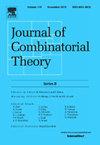EPPA numbers of graphs
IF 1.2
1区 数学
Q1 MATHEMATICS
引用次数: 0
Abstract
If G is a graph, A and B its induced subgraphs, and an isomorphism, we say that f is a partial automorphism of G. In 1992, Hrushovski proved that graphs have the extension property for partial automorphisms (EPPA, also called the Hrushovski property), that is, for every finite graph G there is a finite graph H, an EPPA-witness for G, such that G is an induced subgraph of H and every partial automorphism of G extends to an automorphism of H.
The EPPA number of a graph G, denoted by , is the smallest number of vertices of an EPPA-witness for G, and we put . In this note we review the state of the area, prove several lower bounds (in particular, we show that , thereby identifying the correct base of the exponential) and pose many open questions. We also briefly discuss EPPA numbers of hypergraphs, directed graphs, and -free graphs.
EPPA 图表数量
如果 G 是一个图,A 和 B 是它的诱导子图,f:A→B 是同构,我们就说 f 是 G 的部分自动形。1992 年,赫鲁晓夫斯基证明了图具有部分自动态的扩展性质(EPPA,又称赫鲁晓夫斯基性质),即对于每个有限图 G,都有一个有限图 H(G 的 EPPA 见证),使得 G 是 H 的诱导子图,并且 G 的每个部分自动态都扩展为 H 的一个自动态。图 G 的 EPPA 数(用 eppa(G) 表示)是 G 的 EPPA 证图的最小顶点数,我们将 eppa(n)=max{eppa(G):|G|=n} 放为 eppa(n)=max{eppa(G):|G|=n}。在本说明中,我们回顾了这一领域的现状,证明了几个下界(特别是,我们证明了 eppa(n)≥2nn ,从而确定了指数的正确基数),并提出了许多开放性问题。我们还简要讨论了超图、有向图和无 Kk 图的 EPPA 数。
本文章由计算机程序翻译,如有差异,请以英文原文为准。
求助全文
约1分钟内获得全文
求助全文
来源期刊
CiteScore
2.70
自引率
14.30%
发文量
99
审稿时长
6-12 weeks
期刊介绍:
The Journal of Combinatorial Theory publishes original mathematical research dealing with theoretical and physical aspects of the study of finite and discrete structures in all branches of science. Series B is concerned primarily with graph theory and matroid theory and is a valuable tool for mathematicians and computer scientists.

 求助内容:
求助内容: 应助结果提醒方式:
应助结果提醒方式:


